Pregnancy Induced Hypertension: Causes, Management, and Midwifery Role
VerifiedAdded on 2023/06/04
|16
|4137
|334
Report
AI Summary
This report provides a comprehensive overview of pregnancy-induced hypertension (PIH), also known as toxemia or preeclampsia, a condition characterized by high blood pressure and potential complications during pregnancy. It defines PIH, highlighting its risks, including preeclampsia, and emphasizes the critical roles of medical practitioners and midwives in patient care. The report explores the causes of PIH, including first-time pregnancies, genetics, multiple pregnancies, and pre-existing conditions. It reviews pharmacological management, including the use of antihypertensive medications such as labetalol and nifedipine. The pathophysiology of preeclampsia is discussed, focusing on placental abnormalities and endothelial dysfunction. The report also details the diagnosis of preeclampsia, based on blood pressure and urine analysis, and outlines treatment strategies, including hospitalization, premature delivery, and fetal monitoring. The report emphasizes the significance of safe and effective midwifery care, including the necessary assessments and adherence to registration standards in Australia, as well as the responsibilities of midwives in prescribing and explaining medications. Finally, the report examines the legal and ethical practices of Australia for midwives.
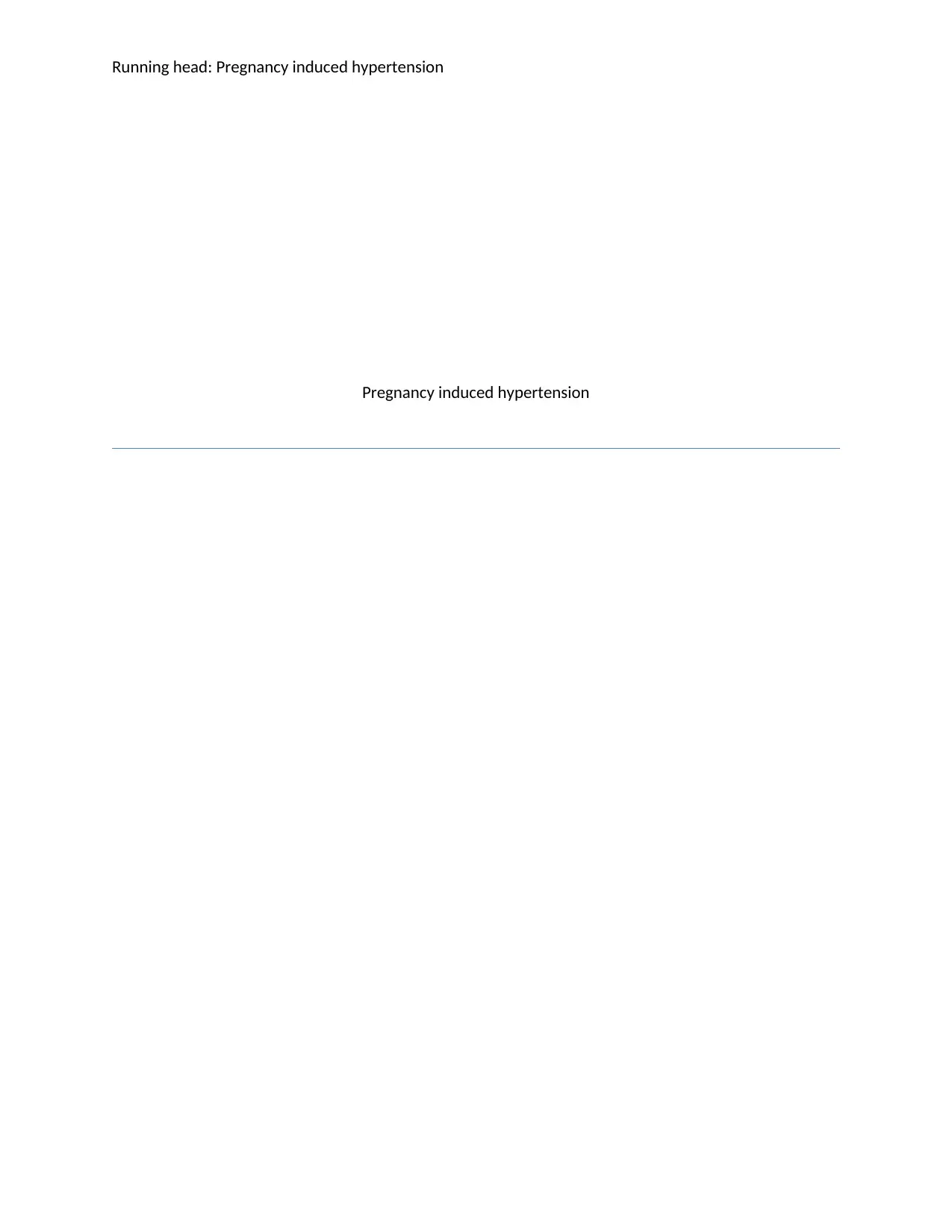
Running head: Pregnancy induced hypertension
Pregnancy induced hypertension
Pregnancy induced hypertension
Paraphrase This Document
Need a fresh take? Get an instant paraphrase of this document with our AI Paraphraser

Pregnancy induced hypertension
Table of Contents
Introduction.................................................................................................................................................3
Literature review on pregnancy induced hypertension................................................................................3
Conclusion.................................................................................................................................................11
References.................................................................................................................................................12
2
Table of Contents
Introduction.................................................................................................................................................3
Literature review on pregnancy induced hypertension................................................................................3
Conclusion.................................................................................................................................................11
References.................................................................................................................................................12
2
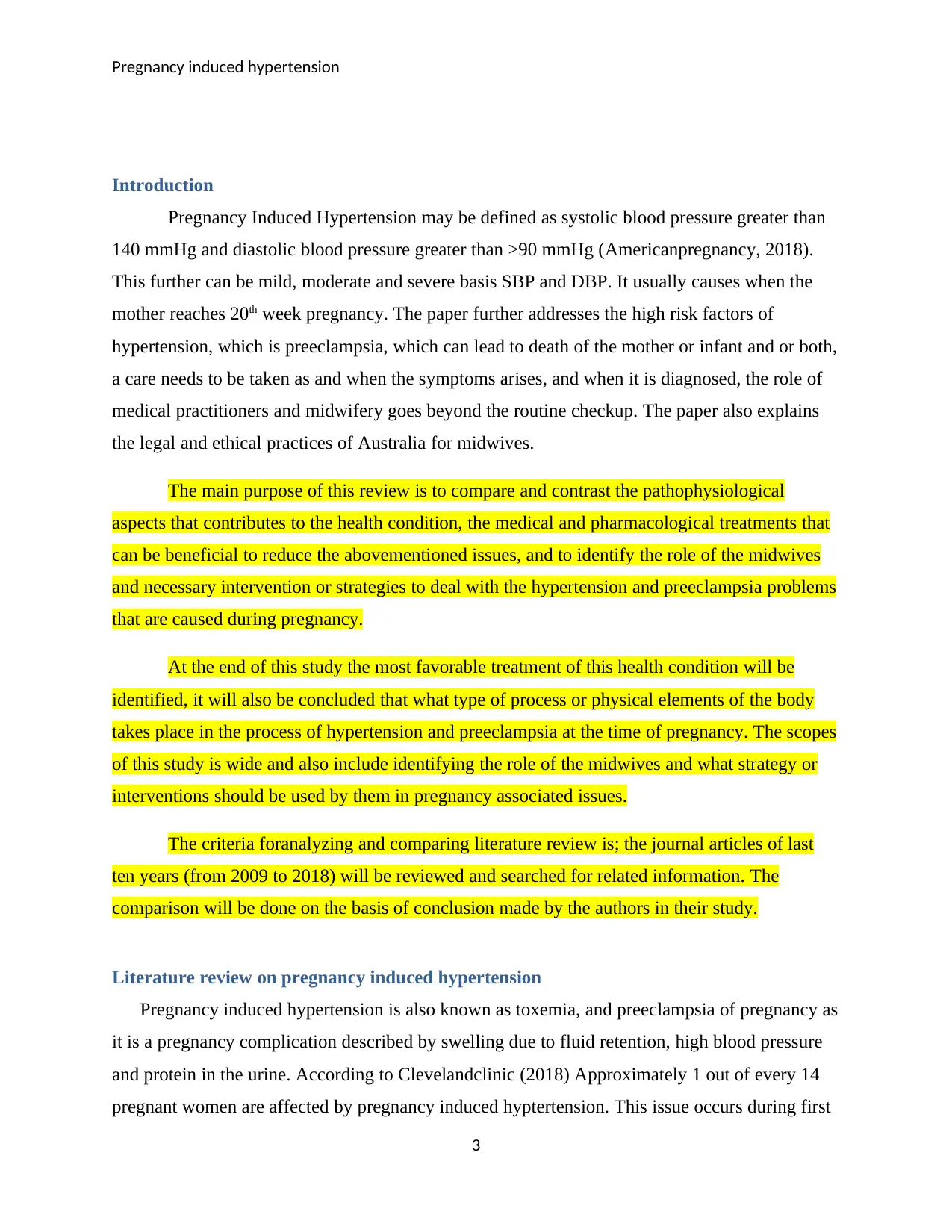
Pregnancy induced hypertension
Introduction
Pregnancy Induced Hypertension may be defined as systolic blood pressure greater than
140 mmHg and diastolic blood pressure greater than >90 mmHg (Americanpregnancy, 2018).
This further can be mild, moderate and severe basis SBP and DBP. It usually causes when the
mother reaches 20th week pregnancy. The paper further addresses the high risk factors of
hypertension, which is preeclampsia, which can lead to death of the mother or infant and or both,
a care needs to be taken as and when the symptoms arises, and when it is diagnosed, the role of
medical practitioners and midwifery goes beyond the routine checkup. The paper also explains
the legal and ethical practices of Australia for midwives.
The main purpose of this review is to compare and contrast the pathophysiological
aspects that contributes to the health condition, the medical and pharmacological treatments that
can be beneficial to reduce the abovementioned issues, and to identify the role of the midwives
and necessary intervention or strategies to deal with the hypertension and preeclampsia problems
that are caused during pregnancy.
At the end of this study the most favorable treatment of this health condition will be
identified, it will also be concluded that what type of process or physical elements of the body
takes place in the process of hypertension and preeclampsia at the time of pregnancy. The scopes
of this study is wide and also include identifying the role of the midwives and what strategy or
interventions should be used by them in pregnancy associated issues.
The criteria foranalyzing and comparing literature review is; the journal articles of last
ten years (from 2009 to 2018) will be reviewed and searched for related information. The
comparison will be done on the basis of conclusion made by the authors in their study.
Literature review on pregnancy induced hypertension
Pregnancy induced hypertension is also known as toxemia, and preeclampsia of pregnancy as
it is a pregnancy complication described by swelling due to fluid retention, high blood pressure
and protein in the urine. According to Clevelandclinic (2018) Approximately 1 out of every 14
pregnant women are affected by pregnancy induced hyptertension. This issue occurs during first
3
Introduction
Pregnancy Induced Hypertension may be defined as systolic blood pressure greater than
140 mmHg and diastolic blood pressure greater than >90 mmHg (Americanpregnancy, 2018).
This further can be mild, moderate and severe basis SBP and DBP. It usually causes when the
mother reaches 20th week pregnancy. The paper further addresses the high risk factors of
hypertension, which is preeclampsia, which can lead to death of the mother or infant and or both,
a care needs to be taken as and when the symptoms arises, and when it is diagnosed, the role of
medical practitioners and midwifery goes beyond the routine checkup. The paper also explains
the legal and ethical practices of Australia for midwives.
The main purpose of this review is to compare and contrast the pathophysiological
aspects that contributes to the health condition, the medical and pharmacological treatments that
can be beneficial to reduce the abovementioned issues, and to identify the role of the midwives
and necessary intervention or strategies to deal with the hypertension and preeclampsia problems
that are caused during pregnancy.
At the end of this study the most favorable treatment of this health condition will be
identified, it will also be concluded that what type of process or physical elements of the body
takes place in the process of hypertension and preeclampsia at the time of pregnancy. The scopes
of this study is wide and also include identifying the role of the midwives and what strategy or
interventions should be used by them in pregnancy associated issues.
The criteria foranalyzing and comparing literature review is; the journal articles of last
ten years (from 2009 to 2018) will be reviewed and searched for related information. The
comparison will be done on the basis of conclusion made by the authors in their study.
Literature review on pregnancy induced hypertension
Pregnancy induced hypertension is also known as toxemia, and preeclampsia of pregnancy as
it is a pregnancy complication described by swelling due to fluid retention, high blood pressure
and protein in the urine. According to Clevelandclinic (2018) Approximately 1 out of every 14
pregnant women are affected by pregnancy induced hyptertension. This issue occurs during first
3
⊘ This is a preview!⊘
Do you want full access?
Subscribe today to unlock all pages.

Trusted by 1+ million students worldwide
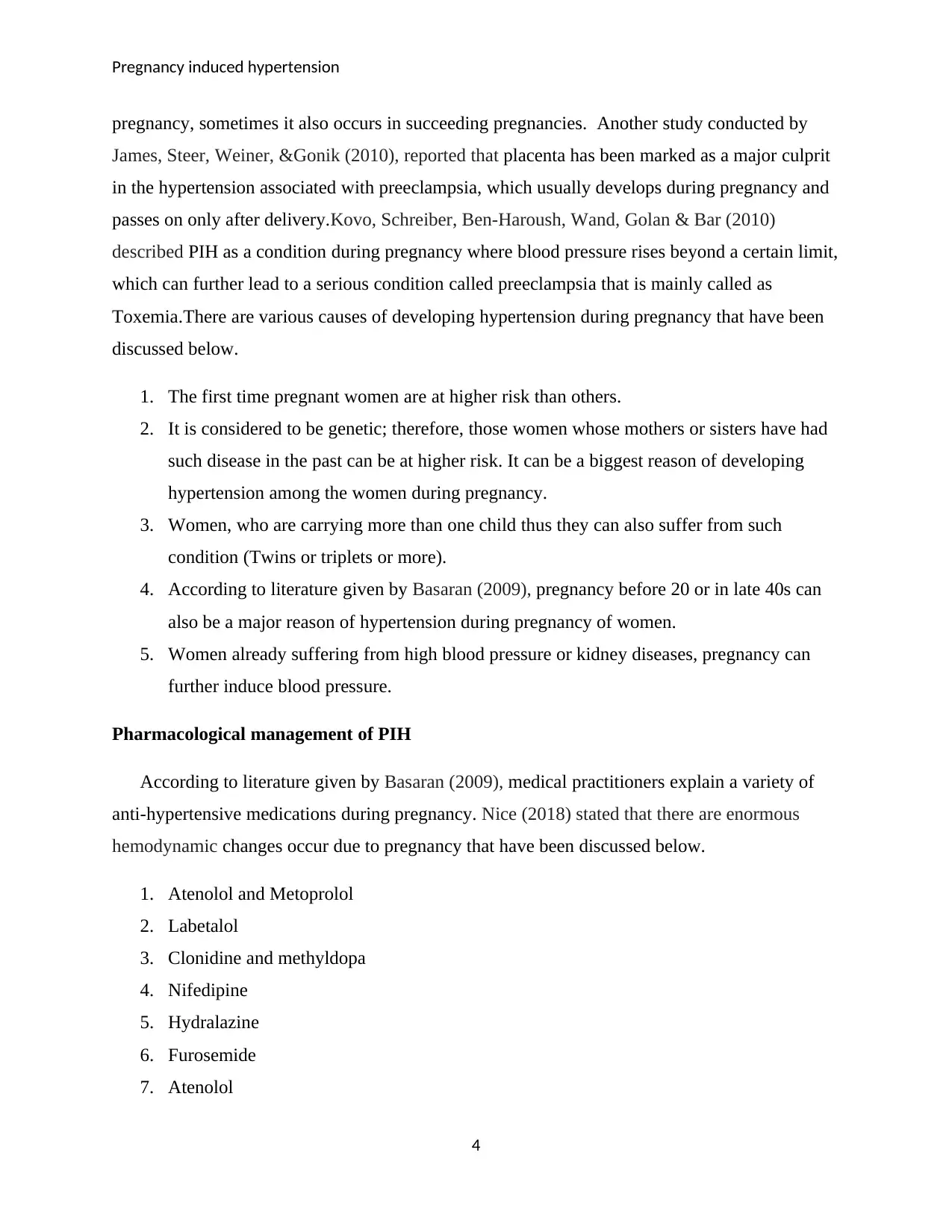
Pregnancy induced hypertension
pregnancy, sometimes it also occurs in succeeding pregnancies. Another study conducted by
James, Steer, Weiner, &Gonik (2010), reported that placenta has been marked as a major culprit
in the hypertension associated with preeclampsia, which usually develops during pregnancy and
passes on only after delivery.Kovo, Schreiber, Ben-Haroush, Wand, Golan & Bar (2010)
described PIH as a condition during pregnancy where blood pressure rises beyond a certain limit,
which can further lead to a serious condition called preeclampsia that is mainly called as
Toxemia.There are various causes of developing hypertension during pregnancy that have been
discussed below.
1. The first time pregnant women are at higher risk than others.
2. It is considered to be genetic; therefore, those women whose mothers or sisters have had
such disease in the past can be at higher risk. It can be a biggest reason of developing
hypertension among the women during pregnancy.
3. Women, who are carrying more than one child thus they can also suffer from such
condition (Twins or triplets or more).
4. According to literature given by Basaran (2009), pregnancy before 20 or in late 40s can
also be a major reason of hypertension during pregnancy of women.
5. Women already suffering from high blood pressure or kidney diseases, pregnancy can
further induce blood pressure.
Pharmacological management of PIH
According to literature given by Basaran (2009), medical practitioners explain a variety of
anti-hypertensive medications during pregnancy. Nice (2018) stated that there are enormous
hemodynamic changes occur due to pregnancy that have been discussed below.
1. Atenolol and Metoprolol
2. Labetalol
3. Clonidine and methyldopa
4. Nifedipine
5. Hydralazine
6. Furosemide
7. Atenolol
4
pregnancy, sometimes it also occurs in succeeding pregnancies. Another study conducted by
James, Steer, Weiner, &Gonik (2010), reported that placenta has been marked as a major culprit
in the hypertension associated with preeclampsia, which usually develops during pregnancy and
passes on only after delivery.Kovo, Schreiber, Ben-Haroush, Wand, Golan & Bar (2010)
described PIH as a condition during pregnancy where blood pressure rises beyond a certain limit,
which can further lead to a serious condition called preeclampsia that is mainly called as
Toxemia.There are various causes of developing hypertension during pregnancy that have been
discussed below.
1. The first time pregnant women are at higher risk than others.
2. It is considered to be genetic; therefore, those women whose mothers or sisters have had
such disease in the past can be at higher risk. It can be a biggest reason of developing
hypertension among the women during pregnancy.
3. Women, who are carrying more than one child thus they can also suffer from such
condition (Twins or triplets or more).
4. According to literature given by Basaran (2009), pregnancy before 20 or in late 40s can
also be a major reason of hypertension during pregnancy of women.
5. Women already suffering from high blood pressure or kidney diseases, pregnancy can
further induce blood pressure.
Pharmacological management of PIH
According to literature given by Basaran (2009), medical practitioners explain a variety of
anti-hypertensive medications during pregnancy. Nice (2018) stated that there are enormous
hemodynamic changes occur due to pregnancy that have been discussed below.
1. Atenolol and Metoprolol
2. Labetalol
3. Clonidine and methyldopa
4. Nifedipine
5. Hydralazine
6. Furosemide
7. Atenolol
4
Paraphrase This Document
Need a fresh take? Get an instant paraphrase of this document with our AI Paraphraser
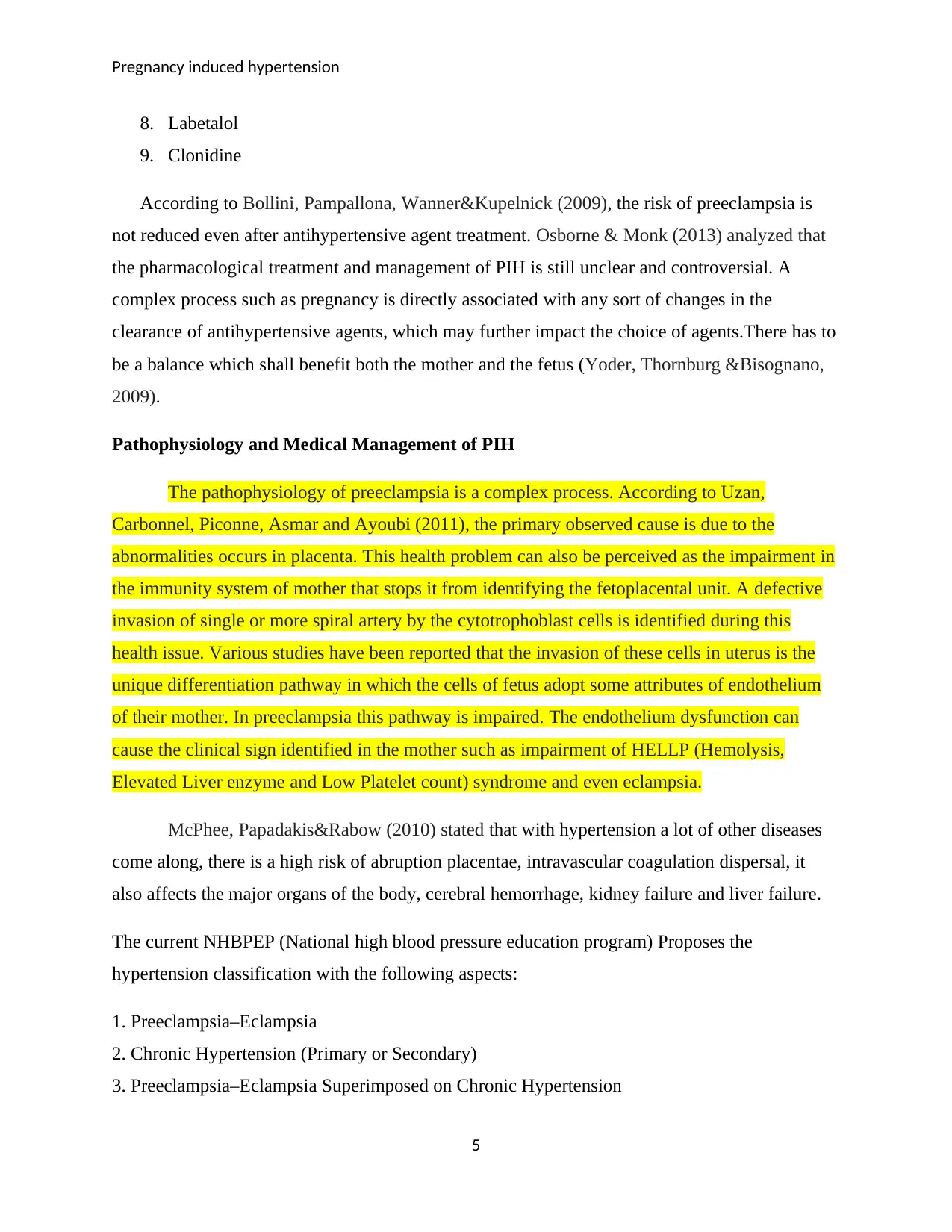
Pregnancy induced hypertension
8. Labetalol
9. Clonidine
According to Bollini, Pampallona, Wanner&Kupelnick (2009), the risk of preeclampsia is
not reduced even after antihypertensive agent treatment. Osborne & Monk (2013) analyzed that
the pharmacological treatment and management of PIH is still unclear and controversial. A
complex process such as pregnancy is directly associated with any sort of changes in the
clearance of antihypertensive agents, which may further impact the choice of agents.There has to
be a balance which shall benefit both the mother and the fetus (Yoder, Thornburg &Bisognano,
2009).
Pathophysiology and Medical Management of PIH
The pathophysiology of preeclampsia is a complex process. According to Uzan,
Carbonnel, Piconne, Asmar and Ayoubi (2011), the primary observed cause is due to the
abnormalities occurs in placenta. This health problem can also be perceived as the impairment in
the immunity system of mother that stops it from identifying the fetoplacental unit. A defective
invasion of single or more spiral artery by the cytotrophoblast cells is identified during this
health issue. Various studies have been reported that the invasion of these cells in uterus is the
unique differentiation pathway in which the cells of fetus adopt some attributes of endothelium
of their mother. In preeclampsia this pathway is impaired. The endothelium dysfunction can
cause the clinical sign identified in the mother such as impairment of HELLP (Hemolysis,
Elevated Liver enzyme and Low Platelet count) syndrome and even eclampsia.
McPhee, Papadakis&Rabow (2010) stated that with hypertension a lot of other diseases
come along, there is a high risk of abruption placentae, intravascular coagulation dispersal, it
also affects the major organs of the body, cerebral hemorrhage, kidney failure and liver failure.
The current NHBPEP (National high blood pressure education program) Proposes the
hypertension classification with the following aspects:
1. Preeclampsia–Eclampsia
2. Chronic Hypertension (Primary or Secondary)
3. Preeclampsia–Eclampsia Superimposed on Chronic Hypertension
5
8. Labetalol
9. Clonidine
According to Bollini, Pampallona, Wanner&Kupelnick (2009), the risk of preeclampsia is
not reduced even after antihypertensive agent treatment. Osborne & Monk (2013) analyzed that
the pharmacological treatment and management of PIH is still unclear and controversial. A
complex process such as pregnancy is directly associated with any sort of changes in the
clearance of antihypertensive agents, which may further impact the choice of agents.There has to
be a balance which shall benefit both the mother and the fetus (Yoder, Thornburg &Bisognano,
2009).
Pathophysiology and Medical Management of PIH
The pathophysiology of preeclampsia is a complex process. According to Uzan,
Carbonnel, Piconne, Asmar and Ayoubi (2011), the primary observed cause is due to the
abnormalities occurs in placenta. This health problem can also be perceived as the impairment in
the immunity system of mother that stops it from identifying the fetoplacental unit. A defective
invasion of single or more spiral artery by the cytotrophoblast cells is identified during this
health issue. Various studies have been reported that the invasion of these cells in uterus is the
unique differentiation pathway in which the cells of fetus adopt some attributes of endothelium
of their mother. In preeclampsia this pathway is impaired. The endothelium dysfunction can
cause the clinical sign identified in the mother such as impairment of HELLP (Hemolysis,
Elevated Liver enzyme and Low Platelet count) syndrome and even eclampsia.
McPhee, Papadakis&Rabow (2010) stated that with hypertension a lot of other diseases
come along, there is a high risk of abruption placentae, intravascular coagulation dispersal, it
also affects the major organs of the body, cerebral hemorrhage, kidney failure and liver failure.
The current NHBPEP (National high blood pressure education program) Proposes the
hypertension classification with the following aspects:
1. Preeclampsia–Eclampsia
2. Chronic Hypertension (Primary or Secondary)
3. Preeclampsia–Eclampsia Superimposed on Chronic Hypertension
5
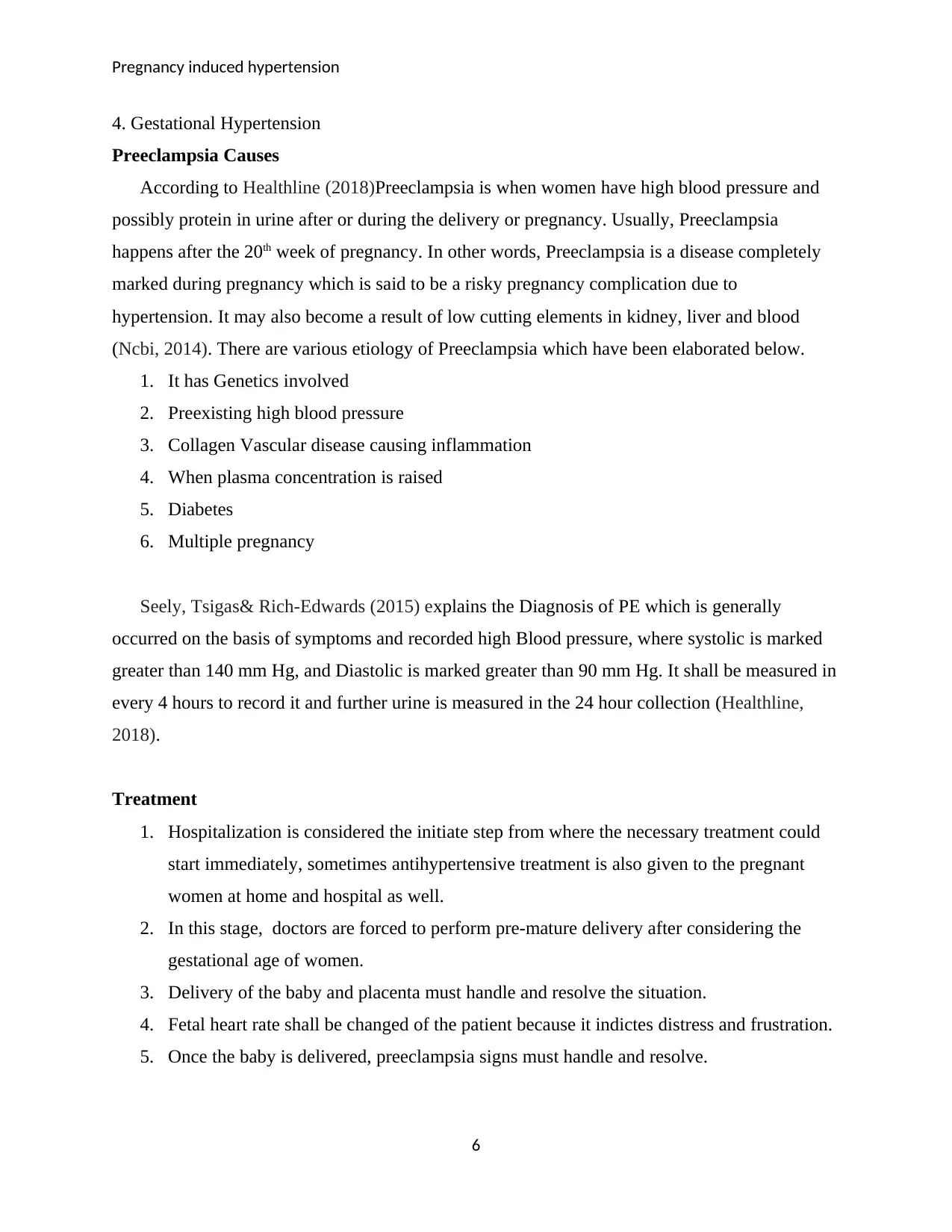
Pregnancy induced hypertension
4. Gestational Hypertension
Preeclampsia Causes
According to Healthline (2018)Preeclampsia is when women have high blood pressure and
possibly protein in urine after or during the delivery or pregnancy. Usually, Preeclampsia
happens after the 20th week of pregnancy. In other words, Preeclampsia is a disease completely
marked during pregnancy which is said to be a risky pregnancy complication due to
hypertension. It may also become a result of low cutting elements in kidney, liver and blood
(Ncbi, 2014). There are various etiology of Preeclampsia which have been elaborated below.
1. It has Genetics involved
2. Preexisting high blood pressure
3. Collagen Vascular disease causing inflammation
4. When plasma concentration is raised
5. Diabetes
6. Multiple pregnancy
Seely, Tsigas& Rich-Edwards (2015) explains the Diagnosis of PE which is generally
occurred on the basis of symptoms and recorded high Blood pressure, where systolic is marked
greater than 140 mm Hg, and Diastolic is marked greater than 90 mm Hg. It shall be measured in
every 4 hours to record it and further urine is measured in the 24 hour collection (Healthline,
2018).
Treatment
1. Hospitalization is considered the initiate step from where the necessary treatment could
start immediately, sometimes antihypertensive treatment is also given to the pregnant
women at home and hospital as well.
2. In this stage, doctors are forced to perform pre-mature delivery after considering the
gestational age of women.
3. Delivery of the baby and placenta must handle and resolve the situation.
4. Fetal heart rate shall be changed of the patient because it indictes distress and frustration.
5. Once the baby is delivered, preeclampsia signs must handle and resolve.
6
4. Gestational Hypertension
Preeclampsia Causes
According to Healthline (2018)Preeclampsia is when women have high blood pressure and
possibly protein in urine after or during the delivery or pregnancy. Usually, Preeclampsia
happens after the 20th week of pregnancy. In other words, Preeclampsia is a disease completely
marked during pregnancy which is said to be a risky pregnancy complication due to
hypertension. It may also become a result of low cutting elements in kidney, liver and blood
(Ncbi, 2014). There are various etiology of Preeclampsia which have been elaborated below.
1. It has Genetics involved
2. Preexisting high blood pressure
3. Collagen Vascular disease causing inflammation
4. When plasma concentration is raised
5. Diabetes
6. Multiple pregnancy
Seely, Tsigas& Rich-Edwards (2015) explains the Diagnosis of PE which is generally
occurred on the basis of symptoms and recorded high Blood pressure, where systolic is marked
greater than 140 mm Hg, and Diastolic is marked greater than 90 mm Hg. It shall be measured in
every 4 hours to record it and further urine is measured in the 24 hour collection (Healthline,
2018).
Treatment
1. Hospitalization is considered the initiate step from where the necessary treatment could
start immediately, sometimes antihypertensive treatment is also given to the pregnant
women at home and hospital as well.
2. In this stage, doctors are forced to perform pre-mature delivery after considering the
gestational age of women.
3. Delivery of the baby and placenta must handle and resolve the situation.
4. Fetal heart rate shall be changed of the patient because it indictes distress and frustration.
5. Once the baby is delivered, preeclampsia signs must handle and resolve.
6
⊘ This is a preview!⊘
Do you want full access?
Subscribe today to unlock all pages.

Trusted by 1+ million students worldwide
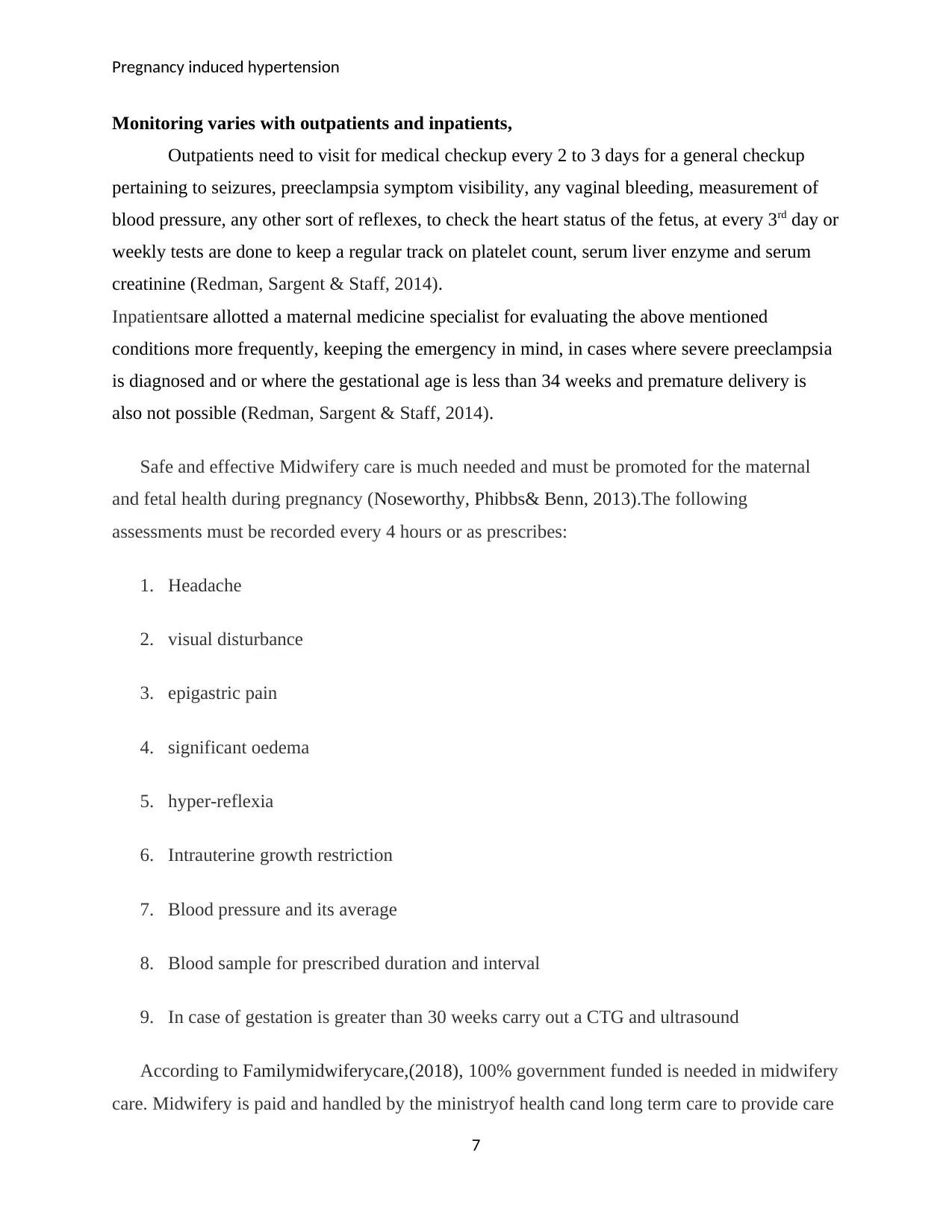
Pregnancy induced hypertension
Monitoring varies with outpatients and inpatients,
Outpatients need to visit for medical checkup every 2 to 3 days for a general checkup
pertaining to seizures, preeclampsia symptom visibility, any vaginal bleeding, measurement of
blood pressure, any other sort of reflexes, to check the heart status of the fetus, at every 3rd day or
weekly tests are done to keep a regular track on platelet count, serum liver enzyme and serum
creatinine (Redman, Sargent & Staff, 2014).
Inpatientsare allotted a maternal medicine specialist for evaluating the above mentioned
conditions more frequently, keeping the emergency in mind, in cases where severe preeclampsia
is diagnosed and or where the gestational age is less than 34 weeks and premature delivery is
also not possible (Redman, Sargent & Staff, 2014).
Safe and effective Midwifery care is much needed and must be promoted for the maternal
and fetal health during pregnancy (Noseworthy, Phibbs& Benn, 2013).The following
assessments must be recorded every 4 hours or as prescribes:
1. Headache
2. visual disturbance
3. epigastric pain
4. significant oedema
5. hyper-reflexia
6. Intrauterine growth restriction
7. Blood pressure and its average
8. Blood sample for prescribed duration and interval
9. In case of gestation is greater than 30 weeks carry out a CTG and ultrasound
According to Familymidwiferycare,(2018), 100% government funded is needed in midwifery
care. Midwifery is paid and handled by the ministryof health cand long term care to provide care
7
Monitoring varies with outpatients and inpatients,
Outpatients need to visit for medical checkup every 2 to 3 days for a general checkup
pertaining to seizures, preeclampsia symptom visibility, any vaginal bleeding, measurement of
blood pressure, any other sort of reflexes, to check the heart status of the fetus, at every 3rd day or
weekly tests are done to keep a regular track on platelet count, serum liver enzyme and serum
creatinine (Redman, Sargent & Staff, 2014).
Inpatientsare allotted a maternal medicine specialist for evaluating the above mentioned
conditions more frequently, keeping the emergency in mind, in cases where severe preeclampsia
is diagnosed and or where the gestational age is less than 34 weeks and premature delivery is
also not possible (Redman, Sargent & Staff, 2014).
Safe and effective Midwifery care is much needed and must be promoted for the maternal
and fetal health during pregnancy (Noseworthy, Phibbs& Benn, 2013).The following
assessments must be recorded every 4 hours or as prescribes:
1. Headache
2. visual disturbance
3. epigastric pain
4. significant oedema
5. hyper-reflexia
6. Intrauterine growth restriction
7. Blood pressure and its average
8. Blood sample for prescribed duration and interval
9. In case of gestation is greater than 30 weeks carry out a CTG and ultrasound
According to Familymidwiferycare,(2018), 100% government funded is needed in midwifery
care. Midwifery is paid and handled by the ministryof health cand long term care to provide care
7
Paraphrase This Document
Need a fresh take? Get an instant paraphrase of this document with our AI Paraphraser

Pregnancy induced hypertension
for women thoroughly pregnancy during rhe birth. It is stated that midwives are registered
specially health care providers. The people also provode fully clinincal care and facilies. It
includes ample of information such as advice, support and excellent choices for dynamic and
unique care. The health care providers work to build and enhance relationship of trust and loyalty
with women and their families because they understand and known that, this will help to improve
and enhance the satisfaction and safety with the experince of birth, pregnancy and early
parenting (Familymidwiferycare,2018). There are two registration standards for the board for
midwifery practice for mother and infant including:
1. Pregnancy
2. Labor
3. Delivery and post natal care
The standards are include
1. Registration Standard for Eligible Midwives
2. Registration Standard for Scheduled Medicines for Eligible Midwives.
There are mandatory six requirements to be accomplished for becoming a recognize and eligible
midwife in Australia . There has to be no restriction on practice in Australia as a midwife with
current registration.
1. There has to be an experience of 3 years, specifically as a midwife post initial
registration.
2. People have to be competent enough to provide any care including Pregnancy, birth,
labor, post natal to women and infants..
3. For a midwife it is needed to provide an additional 20 hour per year of continuing
profession for a continual midwifery care.
8
for women thoroughly pregnancy during rhe birth. It is stated that midwives are registered
specially health care providers. The people also provode fully clinincal care and facilies. It
includes ample of information such as advice, support and excellent choices for dynamic and
unique care. The health care providers work to build and enhance relationship of trust and loyalty
with women and their families because they understand and known that, this will help to improve
and enhance the satisfaction and safety with the experince of birth, pregnancy and early
parenting (Familymidwiferycare,2018). There are two registration standards for the board for
midwifery practice for mother and infant including:
1. Pregnancy
2. Labor
3. Delivery and post natal care
The standards are include
1. Registration Standard for Eligible Midwives
2. Registration Standard for Scheduled Medicines for Eligible Midwives.
There are mandatory six requirements to be accomplished for becoming a recognize and eligible
midwife in Australia . There has to be no restriction on practice in Australia as a midwife with
current registration.
1. There has to be an experience of 3 years, specifically as a midwife post initial
registration.
2. People have to be competent enough to provide any care including Pregnancy, birth,
labor, post natal to women and infants..
3. For a midwife it is needed to provide an additional 20 hour per year of continuing
profession for a continual midwifery care.
8
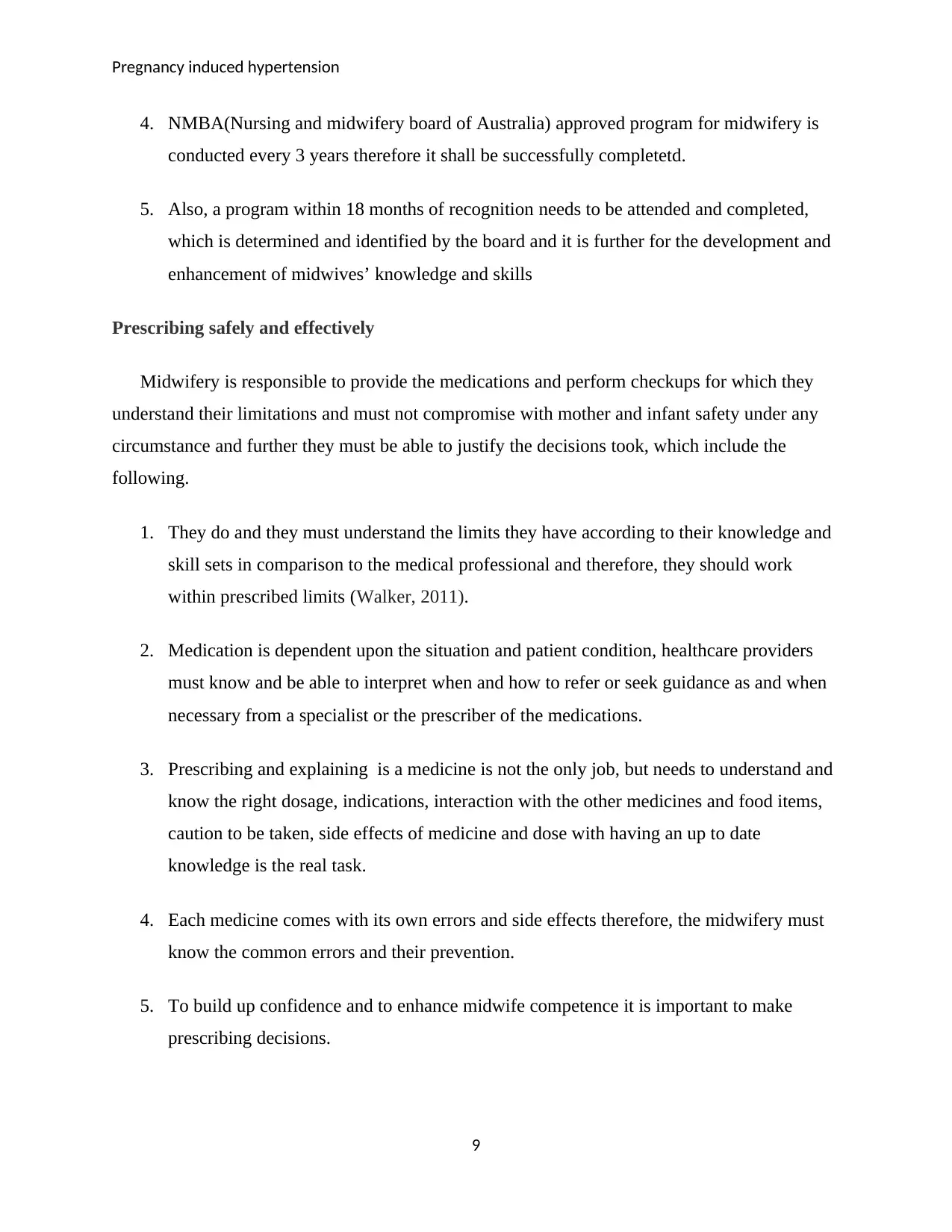
Pregnancy induced hypertension
4. NMBA(Nursing and midwifery board of Australia) approved program for midwifery is
conducted every 3 years therefore it shall be successfully completetd.
5. Also, a program within 18 months of recognition needs to be attended and completed,
which is determined and identified by the board and it is further for the development and
enhancement of midwives’ knowledge and skills
Prescribing safely and effectively
Midwifery is responsible to provide the medications and perform checkups for which they
understand their limitations and must not compromise with mother and infant safety under any
circumstance and further they must be able to justify the decisions took, which include the
following.
1. They do and they must understand the limits they have according to their knowledge and
skill sets in comparison to the medical professional and therefore, they should work
within prescribed limits (Walker, 2011).
2. Medication is dependent upon the situation and patient condition, healthcare providers
must know and be able to interpret when and how to refer or seek guidance as and when
necessary from a specialist or the prescriber of the medications.
3. Prescribing and explaining is a medicine is not the only job, but needs to understand and
know the right dosage, indications, interaction with the other medicines and food items,
caution to be taken, side effects of medicine and dose with having an up to date
knowledge is the real task.
4. Each medicine comes with its own errors and side effects therefore, the midwifery must
know the common errors and their prevention.
5. To build up confidence and to enhance midwife competence it is important to make
prescribing decisions.
9
4. NMBA(Nursing and midwifery board of Australia) approved program for midwifery is
conducted every 3 years therefore it shall be successfully completetd.
5. Also, a program within 18 months of recognition needs to be attended and completed,
which is determined and identified by the board and it is further for the development and
enhancement of midwives’ knowledge and skills
Prescribing safely and effectively
Midwifery is responsible to provide the medications and perform checkups for which they
understand their limitations and must not compromise with mother and infant safety under any
circumstance and further they must be able to justify the decisions took, which include the
following.
1. They do and they must understand the limits they have according to their knowledge and
skill sets in comparison to the medical professional and therefore, they should work
within prescribed limits (Walker, 2011).
2. Medication is dependent upon the situation and patient condition, healthcare providers
must know and be able to interpret when and how to refer or seek guidance as and when
necessary from a specialist or the prescriber of the medications.
3. Prescribing and explaining is a medicine is not the only job, but needs to understand and
know the right dosage, indications, interaction with the other medicines and food items,
caution to be taken, side effects of medicine and dose with having an up to date
knowledge is the real task.
4. Each medicine comes with its own errors and side effects therefore, the midwifery must
know the common errors and their prevention.
5. To build up confidence and to enhance midwife competence it is important to make
prescribing decisions.
9
⊘ This is a preview!⊘
Do you want full access?
Subscribe today to unlock all pages.

Trusted by 1+ million students worldwide
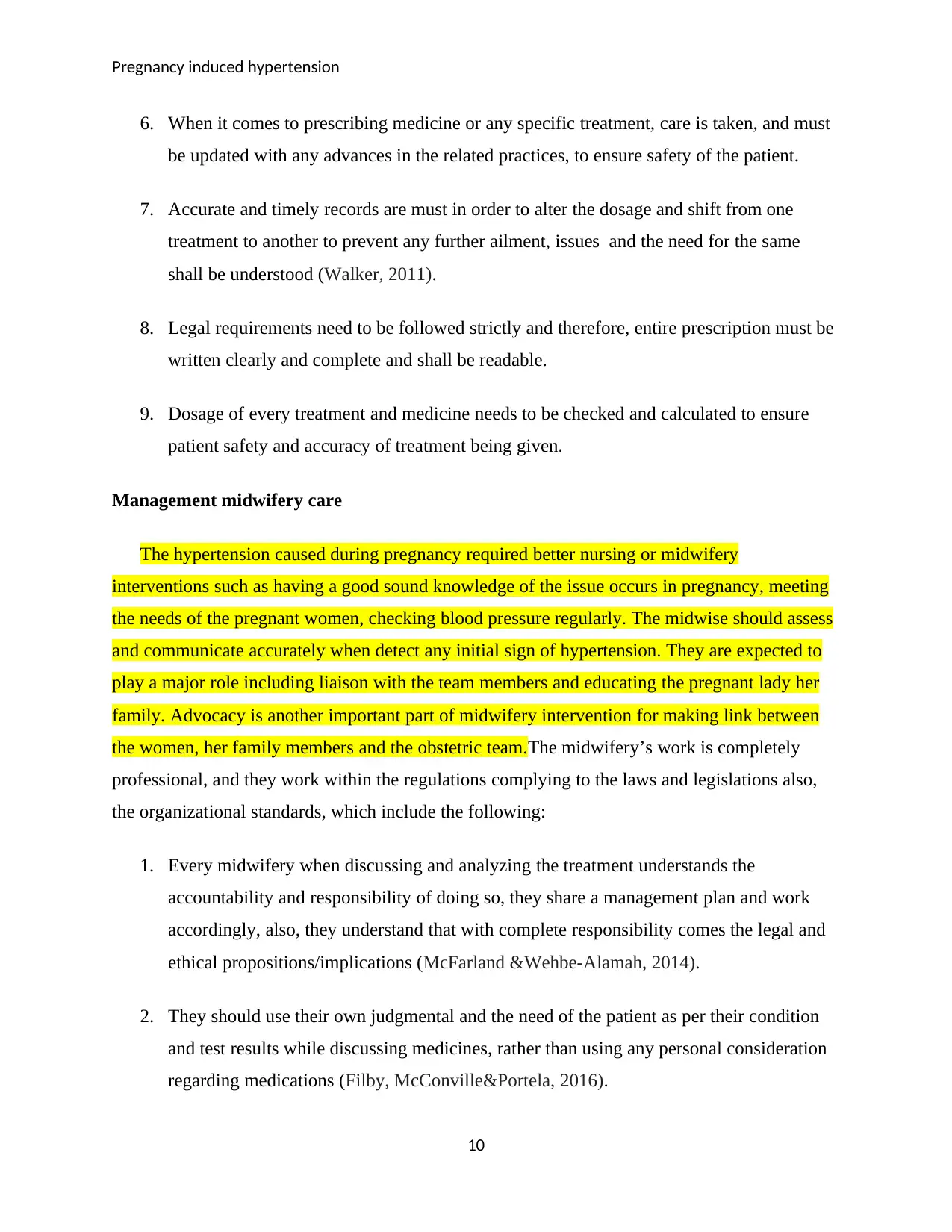
Pregnancy induced hypertension
6. When it comes to prescribing medicine or any specific treatment, care is taken, and must
be updated with any advances in the related practices, to ensure safety of the patient.
7. Accurate and timely records are must in order to alter the dosage and shift from one
treatment to another to prevent any further ailment, issues and the need for the same
shall be understood (Walker, 2011).
8. Legal requirements need to be followed strictly and therefore, entire prescription must be
written clearly and complete and shall be readable.
9. Dosage of every treatment and medicine needs to be checked and calculated to ensure
patient safety and accuracy of treatment being given.
Management midwifery care
The hypertension caused during pregnancy required better nursing or midwifery
interventions such as having a good sound knowledge of the issue occurs in pregnancy, meeting
the needs of the pregnant women, checking blood pressure regularly. The midwise should assess
and communicate accurately when detect any initial sign of hypertension. They are expected to
play a major role including liaison with the team members and educating the pregnant lady her
family. Advocacy is another important part of midwifery intervention for making link between
the women, her family members and the obstetric team.The midwifery’s work is completely
professional, and they work within the regulations complying to the laws and legislations also,
the organizational standards, which include the following:
1. Every midwifery when discussing and analyzing the treatment understands the
accountability and responsibility of doing so, they share a management plan and work
accordingly, also, they understand that with complete responsibility comes the legal and
ethical propositions/implications (McFarland &Wehbe-Alamah, 2014).
2. They should use their own judgmental and the need of the patient as per their condition
and test results while discussing medicines, rather than using any personal consideration
regarding medications (Filby, McConville&Portela, 2016).
10
6. When it comes to prescribing medicine or any specific treatment, care is taken, and must
be updated with any advances in the related practices, to ensure safety of the patient.
7. Accurate and timely records are must in order to alter the dosage and shift from one
treatment to another to prevent any further ailment, issues and the need for the same
shall be understood (Walker, 2011).
8. Legal requirements need to be followed strictly and therefore, entire prescription must be
written clearly and complete and shall be readable.
9. Dosage of every treatment and medicine needs to be checked and calculated to ensure
patient safety and accuracy of treatment being given.
Management midwifery care
The hypertension caused during pregnancy required better nursing or midwifery
interventions such as having a good sound knowledge of the issue occurs in pregnancy, meeting
the needs of the pregnant women, checking blood pressure regularly. The midwise should assess
and communicate accurately when detect any initial sign of hypertension. They are expected to
play a major role including liaison with the team members and educating the pregnant lady her
family. Advocacy is another important part of midwifery intervention for making link between
the women, her family members and the obstetric team.The midwifery’s work is completely
professional, and they work within the regulations complying to the laws and legislations also,
the organizational standards, which include the following:
1. Every midwifery when discussing and analyzing the treatment understands the
accountability and responsibility of doing so, they share a management plan and work
accordingly, also, they understand that with complete responsibility comes the legal and
ethical propositions/implications (McFarland &Wehbe-Alamah, 2014).
2. They should use their own judgmental and the need of the patient as per their condition
and test results while discussing medicines, rather than using any personal consideration
regarding medications (Filby, McConville&Portela, 2016).
10
Paraphrase This Document
Need a fresh take? Get an instant paraphrase of this document with our AI Paraphraser
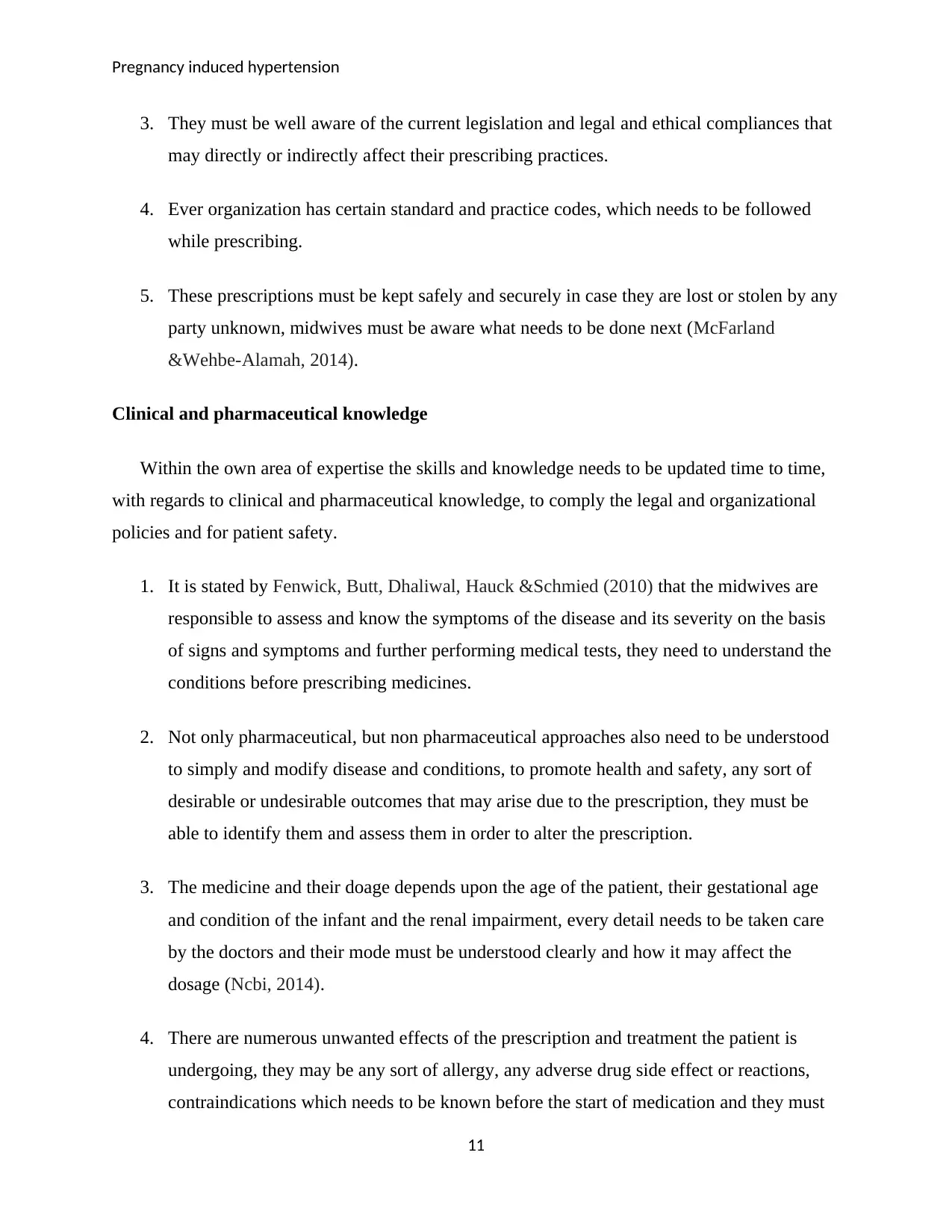
Pregnancy induced hypertension
3. They must be well aware of the current legislation and legal and ethical compliances that
may directly or indirectly affect their prescribing practices.
4. Ever organization has certain standard and practice codes, which needs to be followed
while prescribing.
5. These prescriptions must be kept safely and securely in case they are lost or stolen by any
party unknown, midwives must be aware what needs to be done next (McFarland
&Wehbe-Alamah, 2014).
Clinical and pharmaceutical knowledge
Within the own area of expertise the skills and knowledge needs to be updated time to time,
with regards to clinical and pharmaceutical knowledge, to comply the legal and organizational
policies and for patient safety.
1. It is stated by Fenwick, Butt, Dhaliwal, Hauck &Schmied (2010) that the midwives are
responsible to assess and know the symptoms of the disease and its severity on the basis
of signs and symptoms and further performing medical tests, they need to understand the
conditions before prescribing medicines.
2. Not only pharmaceutical, but non pharmaceutical approaches also need to be understood
to simply and modify disease and conditions, to promote health and safety, any sort of
desirable or undesirable outcomes that may arise due to the prescription, they must be
able to identify them and assess them in order to alter the prescription.
3. The medicine and their doage depends upon the age of the patient, their gestational age
and condition of the infant and the renal impairment, every detail needs to be taken care
by the doctors and their mode must be understood clearly and how it may affect the
dosage (Ncbi, 2014).
4. There are numerous unwanted effects of the prescription and treatment the patient is
undergoing, they may be any sort of allergy, any adverse drug side effect or reactions,
contraindications which needs to be known before the start of medication and they must
11
3. They must be well aware of the current legislation and legal and ethical compliances that
may directly or indirectly affect their prescribing practices.
4. Ever organization has certain standard and practice codes, which needs to be followed
while prescribing.
5. These prescriptions must be kept safely and securely in case they are lost or stolen by any
party unknown, midwives must be aware what needs to be done next (McFarland
&Wehbe-Alamah, 2014).
Clinical and pharmaceutical knowledge
Within the own area of expertise the skills and knowledge needs to be updated time to time,
with regards to clinical and pharmaceutical knowledge, to comply the legal and organizational
policies and for patient safety.
1. It is stated by Fenwick, Butt, Dhaliwal, Hauck &Schmied (2010) that the midwives are
responsible to assess and know the symptoms of the disease and its severity on the basis
of signs and symptoms and further performing medical tests, they need to understand the
conditions before prescribing medicines.
2. Not only pharmaceutical, but non pharmaceutical approaches also need to be understood
to simply and modify disease and conditions, to promote health and safety, any sort of
desirable or undesirable outcomes that may arise due to the prescription, they must be
able to identify them and assess them in order to alter the prescription.
3. The medicine and their doage depends upon the age of the patient, their gestational age
and condition of the infant and the renal impairment, every detail needs to be taken care
by the doctors and their mode must be understood clearly and how it may affect the
dosage (Ncbi, 2014).
4. There are numerous unwanted effects of the prescription and treatment the patient is
undergoing, they may be any sort of allergy, any adverse drug side effect or reactions,
contraindications which needs to be known before the start of medication and they must
11
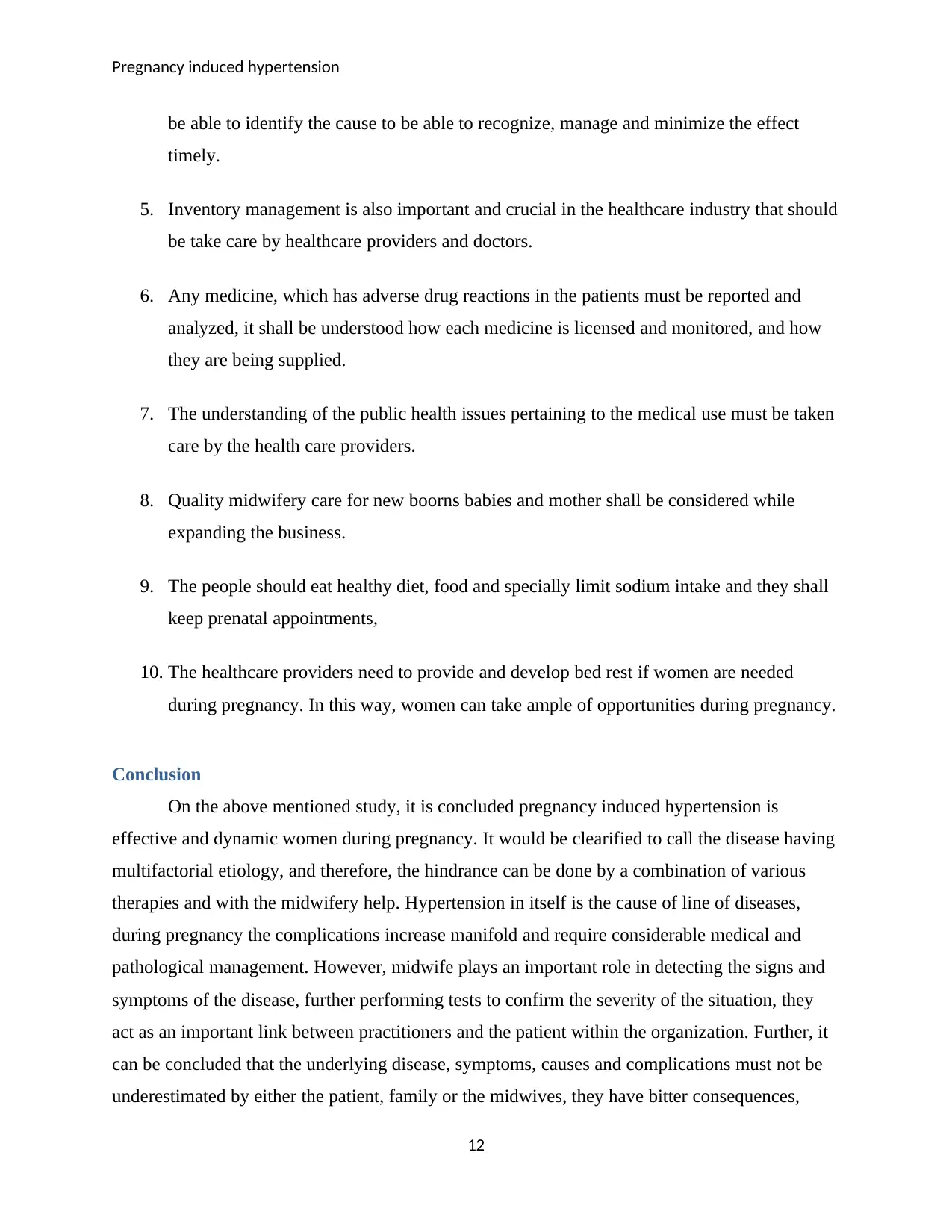
Pregnancy induced hypertension
be able to identify the cause to be able to recognize, manage and minimize the effect
timely.
5. Inventory management is also important and crucial in the healthcare industry that should
be take care by healthcare providers and doctors.
6. Any medicine, which has adverse drug reactions in the patients must be reported and
analyzed, it shall be understood how each medicine is licensed and monitored, and how
they are being supplied.
7. The understanding of the public health issues pertaining to the medical use must be taken
care by the health care providers.
8. Quality midwifery care for new boorns babies and mother shall be considered while
expanding the business.
9. The people should eat healthy diet, food and specially limit sodium intake and they shall
keep prenatal appointments,
10. The healthcare providers need to provide and develop bed rest if women are needed
during pregnancy. In this way, women can take ample of opportunities during pregnancy.
Conclusion
On the above mentioned study, it is concluded pregnancy induced hypertension is
effective and dynamic women during pregnancy. It would be clearified to call the disease having
multifactorial etiology, and therefore, the hindrance can be done by a combination of various
therapies and with the midwifery help. Hypertension in itself is the cause of line of diseases,
during pregnancy the complications increase manifold and require considerable medical and
pathological management. However, midwife plays an important role in detecting the signs and
symptoms of the disease, further performing tests to confirm the severity of the situation, they
act as an important link between practitioners and the patient within the organization. Further, it
can be concluded that the underlying disease, symptoms, causes and complications must not be
underestimated by either the patient, family or the midwives, they have bitter consequences,
12
be able to identify the cause to be able to recognize, manage and minimize the effect
timely.
5. Inventory management is also important and crucial in the healthcare industry that should
be take care by healthcare providers and doctors.
6. Any medicine, which has adverse drug reactions in the patients must be reported and
analyzed, it shall be understood how each medicine is licensed and monitored, and how
they are being supplied.
7. The understanding of the public health issues pertaining to the medical use must be taken
care by the health care providers.
8. Quality midwifery care for new boorns babies and mother shall be considered while
expanding the business.
9. The people should eat healthy diet, food and specially limit sodium intake and they shall
keep prenatal appointments,
10. The healthcare providers need to provide and develop bed rest if women are needed
during pregnancy. In this way, women can take ample of opportunities during pregnancy.
Conclusion
On the above mentioned study, it is concluded pregnancy induced hypertension is
effective and dynamic women during pregnancy. It would be clearified to call the disease having
multifactorial etiology, and therefore, the hindrance can be done by a combination of various
therapies and with the midwifery help. Hypertension in itself is the cause of line of diseases,
during pregnancy the complications increase manifold and require considerable medical and
pathological management. However, midwife plays an important role in detecting the signs and
symptoms of the disease, further performing tests to confirm the severity of the situation, they
act as an important link between practitioners and the patient within the organization. Further, it
can be concluded that the underlying disease, symptoms, causes and complications must not be
underestimated by either the patient, family or the midwives, they have bitter consequences,
12
⊘ This is a preview!⊘
Do you want full access?
Subscribe today to unlock all pages.

Trusted by 1+ million students worldwide
1 out of 16
Related Documents
Your All-in-One AI-Powered Toolkit for Academic Success.
+13062052269
info@desklib.com
Available 24*7 on WhatsApp / Email
![[object Object]](/_next/static/media/star-bottom.7253800d.svg)
Unlock your academic potential
Copyright © 2020–2026 A2Z Services. All Rights Reserved. Developed and managed by ZUCOL.




